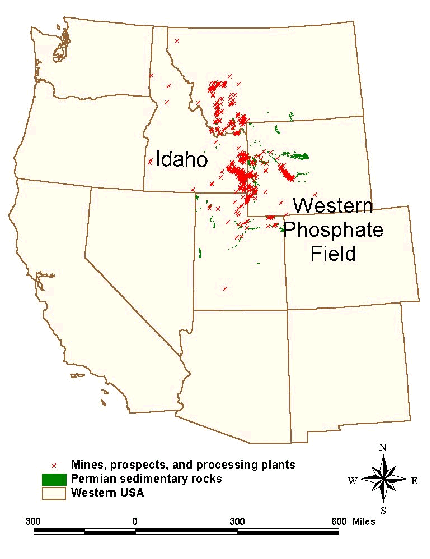Western Mineral Resources
Project status is complete. Please check the project list for currently active projects
"This research effort employs integrated, multifaceted, multidisciplinary, multiagency scientific investigations designed to improve our understanding of ore deposition and extent, alteration, weathering, ore concentration, and trace element concentration, mobilization, and transport processes."
 |
PROJECT SUMMARY:U.S. Geological Survey scientists associated with this project, a response to Federal land management needs, are studying the elemental, mineralogical, petrochemical, and stratigraphic character of phosphate mineralization within the Southeast Idaho Phosphate District and in selected portions of the Western Phosphate Field. Impacts on the environment associated with the presence and development of the Phosphoria Formation are also being examined. Concentrated initially in Southeast Idaho, this study is enhancing our ability to evaluate additional phosphate mineralization and to anticipate, assess, and mitigate environmental hazards, such as selenium toxicity, that are spatially associated with the existence and societal use (mining and reclamation) of the phosphate. BACKGROUND:Phosphorus, an industrial commodity as well as a nutrient essential to all life including crop production, is present in economically mineable quantities in organic-rich black shales of the Permian Phosphoria and related formations, which constitute the Western Phosphate Field. Four major open pit mines in the SE Idaho Phosphate District produce phosphate from the Meade Peak Phosphatic Shale Member and related units. The ore produced is a major source of both phosphate fertilizer and elemental phosphorus. About 12 percent of the nations annual need for phosphate is provided by the Phosphoria Formation. More information on this important industrial commodity may be found at http://minerals.usgs.gov/minerals/pubs/commodity/phosphate_rock/. The organic-rich black shales that host phosphate also contain significant concentrations of potentially toxic trace elements, including arsenic, cadmium, copper, molybdenum, lead, antimony, selenium, vadadium, zinc, and others. In 1996, several horses pastured near a phosphate waste dump in SE Idaho were euthanized due to severe selenium toxicosis. Additional selenium problems are documented. These problems have occurred despite detailed, multi-agency investigations undertaken in the 1970's for an Environmental Impact Statement on proposed mining, which suggested that toxic element releases would be unlikely because the "carbonaceous" system is "buffered." |
Return to: All Western Mineral Resources Projects | Western Mineral Resources Team Homepage
| Mineral Resources | Eastern / Central / Western / Alaska / Minerals Information |
| Crustal Imaging & Characterization / Spatial Data |